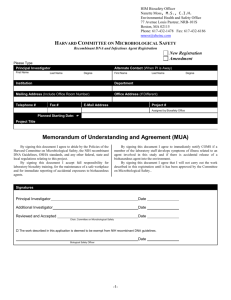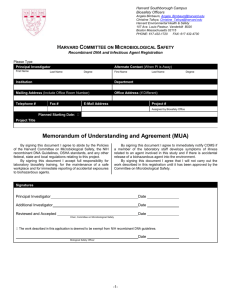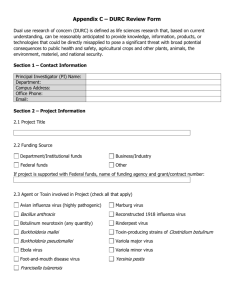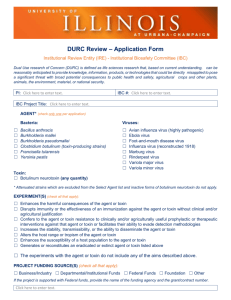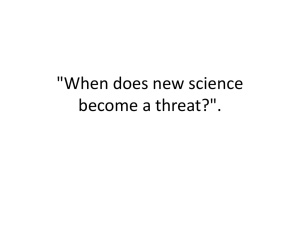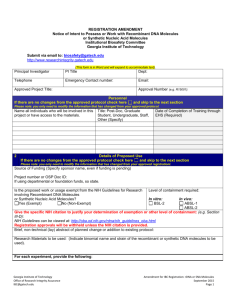BWH Recombinant DNA application
advertisement
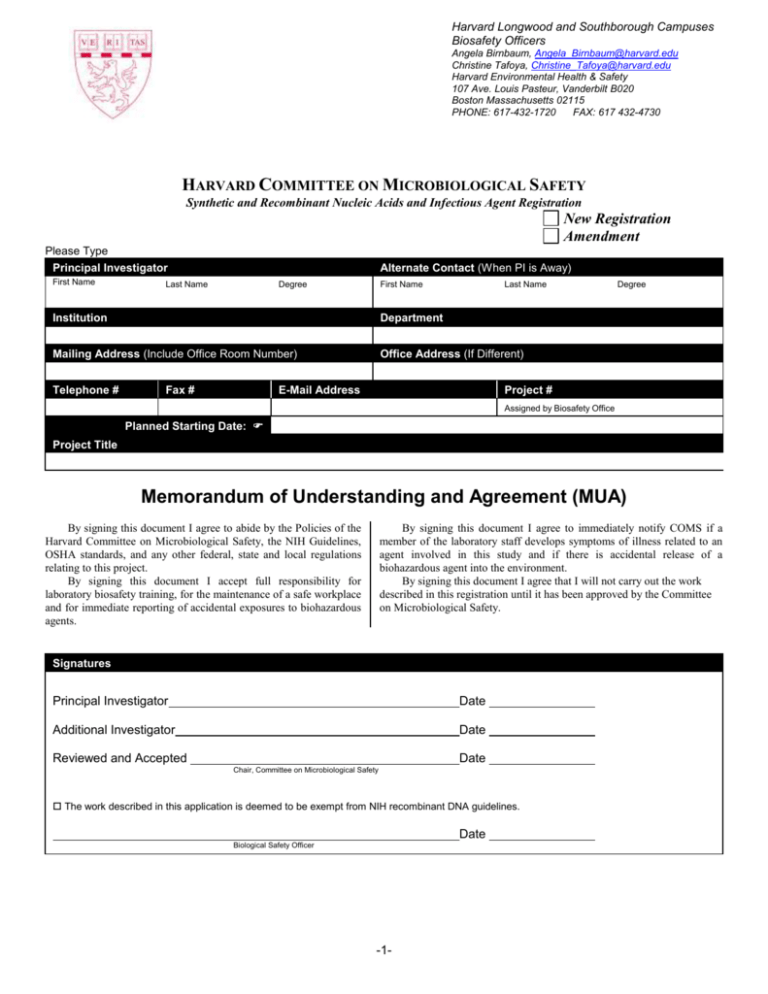
Harvard Longwood and Southborough Campuses Biosafety Officers Angela Birnbaum, Angela_Birnbaum@harvard.edu Christine Tafoya, Christine_Tafoya@harvard.edu Harvard Environmental Health & Safety 107 Ave. Louis Pasteur, Vanderbilt B020 Boston Massachusetts 02115 PHONE: 617-432-1720 FAX: 617 432-4730 HARVARD COMMITTEE ON MICROBIOLOGICAL SAFETY Synthetic and Recombinant Nucleic Acids and Infectious Agent Registration New Registration Amendment Please Type Principal Investigator First Name Alternate Contact (When PI is Away) Last Name Degree First Name Last Name Institution Department Mailing Address (Include Office Room Number) Office Address (If Different) Telephone # Fax # E-Mail Address Degree Project # Assigned by Biosafety Office Planned Starting Date: Project Title Memorandum of Understanding and Agreement (MUA) By signing this document I agree to abide by the Policies of the Harvard Committee on Microbiological Safety, the NIH Guidelines, OSHA standards, and any other federal, state and local regulations relating to this project. By signing this document I accept full responsibility for laboratory biosafety training, for the maintenance of a safe workplace and for immediate reporting of accidental exposures to biohazardous agents. By signing this document I agree to immediately notify COMS if a member of the laboratory staff develops symptoms of illness related to an agent involved in this study and if there is accidental release of a biohazardous agent into the environment. By signing this document I agree that I will not carry out the work described in this registration until it has been approved by the Committee on Microbiological Safety. Signatures Principal Investigator Date Additional Investigator Date Reviewed and Accepted Date Chair, Committee on Microbiological Safety The work described in this application is deemed to be exempt from NIH recombinant DNA guidelines. Date Biological Safety Officer -1- Non-Technical Summary of Proposed Work (Please Expand Acronyms) Describe the Experiment in Detail Please give references where appropriate. (Please Expand Acronyms) Location of Work. (Include building and room numbers) List Other Personnel Associated with the Project. Describe the Biohazard Potential of These Experiments Are special medical surveillance practices recommended? Human Tissues (Please identify the source of each) (Please Expand Acronyms) Unfixed human tissues or fluids, e.g. Human blood, lymph, CSF, plasma, secretions, established human cell lines. If so, please list cells by name and source Is it possible to ascertain the identity of the person from whom the sample originated? YES: , NO: Comment: Human Embryonic Stem Cells? Check for “yes:” From Fertilized Ova? Human Somatic Cell Nuclear Transfer? Reprogrammed somatic cells? , , Please list cells by name and source: Prokaryotic Experiments (Please identify the source of each organism and vector) (Please Expand Acronyms) Host Strains (Please note whether an E.coli K12 based strain is to be used) Plasmids, Bacterial Vectors (Please Inserted DNA (Include names of genes, promoters, note pBR based plasmids) enhancers . . .organisms from which they were cloned) Eukaryotic Experiments (Please identify the source of each organism and vector) (Please Expand Acronyms) Cell Lines and Strains: Vectors (Include details if vector is a Vector Packaging System: human pathogen, e.g.: adenovirus, retrovirus,...) Fraction of eukaryotic viral genome in recombinant DNA <½_ _, >½ but <2/3_ Eukaryotic Viruses (Please identify the source of each) (Please Expand Acronyms) _, >2/3_ ____ Into Viruses or Viral Vectors Inserted DNA (Include names of genes, promoters, enhancers . . .organisms from which they were cloned) Plant or Animal Experiments (Please identify the source of each organism and vector) (Please Expand Acronyms) Plants or Animals Vectors Inserted DNA (Include names of genes, promoters, enhancers . . .organisms from which they were cloned) Source(s) of Transgenics: Transgenic Plants or Animals? Animals or Plants: Describe Agent Administration – route, volume, concentration “Select Agents*”: Toxins or microbiologicals (Please identify the source of each organism or toxin) Synthetic Nucleic Acids Some work with synthetic nucleic acids is exempt from the NIH regulations and does not require COMS registration. For example, use of oligonucleotides (e.g., for PCR and microarrays) might not require COMS registration. Synthetic nucleic acids that meet all three of the following criteria do not require registration with COMS. Synthetic nucleic acids that: 1. Can neither replicate nor generate nucleic acids that can replicate in any living cell (do not contain an origin of replication or contain elements to interact with DNA or RNA polymerase) and 2. Are not designed to integrate into DNA and 3. Do not produce a toxin that is lethal for vertebrates at an LD50 of less than 100 nanograms per kilogram of “Select Agents” are thought to be useful to terrorists. The Centers for Disease Control and US Department of Agriculture publish a list of these agents. They require CDC or USDA permits for their use and shipment. Please consult the Biosafety Office if you are in doubt. The penalties for error are severe. * body weight. Other categories of work with synthetic nucleic acids that are exempt from registration under the NIH Guidelines can be found in those guidelines and in the COMS manual. Please consult with your BSO if you need assistance determining whether the synthetic nucleic acids require COMS registration. Dual Use Research of Concern (DURC): Please check any that apply to your study. If None apply, check here: . Purpose: The purpose is to ensure that research can be conducted safely and in full compliance. Definition of Dual Use Research of Concern (DURC) DURC is life sciences research that, based on current understanding, can be reasonably anticipated to provide knowledge, information, products, or technologies that could be directly misapplied to pose a significant threat with broad potential consequences to public health and safety, agricultural crops and other plants, animals, the environment, material, or national security. The United States Government has designated a specific group of highconsequence agents and toxins for specific review, however DURC is not limited to these agents and toxins. Please check both categories of experiments to be performed, and agents and toxins to be used in this research. Categories of experiments: Enhances the harmful consequences of the agent or toxin Disrupts immunity or the effectiveness of an immunization against the agent or toxin without clinical or agricultural justification Confers to the agent or toxin resistance to clinically or agriculturally useful prophylactic or therapeutic interventions against that agent or toxin or facilitates their ability to evade detection methodologies Increases the stability, transmissibility, or the ability to disseminate the agent or toxin Alters the host range or tropism of the agent or toxin Enhances the susceptibility of a host population to the agent or toxin; Generates or reconstitutes an eradicated or extinct agent or toxin Agents and toxins: Avian influenza virus (highly pathogenic) Bacillus anthracis Botulinum neurotoxin Burkholderia mallei Burkholderia pseudomallei Ebola virus Foot-and-mouth disease virus Francisella tularensis Marburg virus Reconstructed 1918 Influenza virus Rinderpest virus Toxin-producing strains of Clostridium botulinum Variola major virus Variola minor virus Yersinia pestis Please explain why you think this is or is not dual use research of concern: BOSTON PUBLIC HEALTH COMMISSION ENVIRONMENTAL HEALTH OFFICE 1010 Massachusetts Avenue Boston, MA 02118 phone (617) 534-5965 FAX (617) 534-2372 Title: Anticipated Starting Date: Brief Description of Project: Institution: Lab Facility Address(es) Building(s): Room(s): Principal Investigator(s): X__, Is an RDNA gene product efficiently expressed: Yes__X_ No __ Containment Levels (date and subsection of applicable NIH Guidelines): Host-Vector-Donor System: Lab Personnel to contact in emergency situations requiring immediate remedial action: Certification: 1. I am familiar with and agree to abide by the provisions of the City of Boston Recombinant DNA Technology: Use Regulations. The information above is accurate and complete. Principal Investigator:______________________________ Date:____________________ 2a. I certify that the Institutional Biosafety Committee (IBC) has reviewed on _________________ the proposed project for RDNA and has by a majority vote found it in compliance with the provisions of the City of Boston Recombinant DNA Technology: Use Regulations. The IBC will monitor the project throughout its duration to ensure its compliance with City of Boston Regulations. Chairperson, Biosafety Committee:____________________ Date:____________________ OR 2b. I certify that I have been authorized by the IBC to administratively review and approve Class II-D, E experiments or by an Institutional Review Body (IRB) to administratively review and approve Class III-E experiments. The proposed project has been found to be in compliance with the City of Boston Recombinant DNA Technology: Use Regulations. The institution will monitor the project throughout its duration to ensure its compliance with City of Boston Regulations. Officer:___________________________________________ Date:____________________
